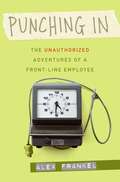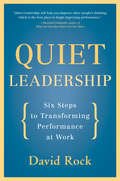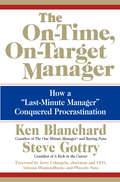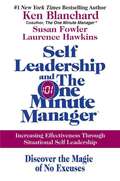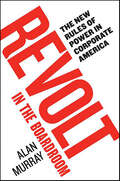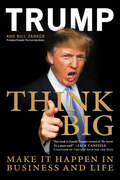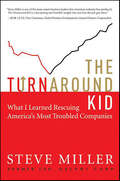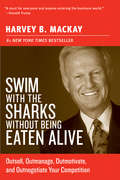- Table View
- List View
Mr. Lincoln's T-Mails: The Untold Story of How Abraham Lincoln Used the Telegraph to Win the Civil War
by Tom WheelerThis “intriguing” look at the sixteenth president’s telegraph usage during the Civil War “revisits a familiar hero, but does so from an utterly new perspective” (Ken Burns).The Civil War was the first “modern war.” Because of rapid changes in American society, Abraham Lincoln became president of a divided United States during a period of technological and social revolution. Among the many modern marvels that gave the North an advantage was the telegraph, which Lincoln used to stay connected to the forces in the field in almost real time.No leader in history had ever possessed such a powerful tool to gain control over a fractious situation. An eager student of technology, Lincoln (the only president to hold a patent) had to learn to use the power of electronic messages. Without precedent to guide him, Lincoln began by reading the telegraph traffic among his generals. Then he used the telegraph to supplement his preferred form of communication—meetings and letters. He did not replace those face-to-face interactions. Through this experience, Lincoln crafted the best way to guide, reprimand, praise, reward, and encourage his commanders in the field.Written by a former FCC chairman, Mr. Lincoln’s T-Mails tells a big story within a small compass—both an elegant work of history and a timeless lesson in leadership. By paying close attention to Lincoln’s “lightning messages,” we see a great leader adapt to a new medium. No reader of this work of history will be able to miss the contemporary parallels. Watching Lincoln carefully word his messages—and follow up on those words with the right actions—offers a striking example for those who spend their days tapping out notes on their various devices.“Mr. Lincoln’s T-Mails shines. . . . an accessible jaunt through this formative American event.” —USA Today“Wheeler shows a Lincoln groping for a best-use of new technology and learning the limitations of the ‘killer app.’”—Booklist“Altogether captivating.” —Harold Holzer, author of Brought Forth on This Continent: Abraham Lincoln and American Immigration
The New Market Wizards: Conversations with America's Top Traders
by Jack D. SchwagerIn The New Market Wizards, successful traders relate the financial strategies that have rocketed them to success. Asking questions that readers with an interest or involvement in the financial markets would love to pose to the financial superstars, Jack D. Schwager encourages these financial wizards to share their insights. Entertaining, informative, and invaluable, The New Market Wizards is destined to become another Schwager classic.
Punching In
by Alex FrankelDuring a two-year urban adventure through the world of commerce, journalist Alex Frankel proudly wore the brown uniform of the UPS driver, folded endless stacks of T-shirts at Gap, brewed espressos for the hordes at Starbucks, interviewed (but failed to get hired) at Whole Foods, enrolled in management training at Enterprise Rent-A-Car, and sold iPods at the Apple Store. In this lively and entertaining narrative, Frankel takes readers on a personal journey into the land of front-line employees to discover why some workers are so eager to drink the corporate Kool-Aid and which companies know how to serve it up best.
The Pursuit of Happyness: The Life Story That Inspired the Major Motion Picture
by Chris Gardner Quincy TroupeThe rags-to-riches saga of a homeless father who went on to become a crown prince of Wall Street—the basis for the major motion picture starring Will Smith.At the age of twenty, Milwaukee native Chris Gardner, just out of the Navy, arrived in San Francisco to pursue a promising career in medicine. Considered a prodigy in scientific research, he surprised everyone and himself by setting his sights on the competitive world of high finance. Yet no sooner had he landed an entry-level position at a prestigious firm than Gardner found himself caught in a web of incredibly challenging circumstances that left him as part of the city’s working homeless and with a toddler son. Motivated by the promise he made to himself as a fatherless child to never abandon his own children, the two spent almost a year moving among shelters, “HO-tels,” soup lines, and even sleeping in the public restroom of a subway station.Never giving in to despair, Gardner made an astonishing transformation from being part of the city’s invisible poor to being a powerful player in its financial district.More than a memoir of Gardner’s financial success, this is the story of a man who breaks his own family’s cycle of men abandoning their children. Mythic, triumphant, and unstintingly honest, The Pursuit of Happyness conjures heroes like Horatio Alger and Antwone Fisher, and appeals to the very essence of the American Dream.“Gardner is honest and thorough as he solidly depicts growing up black and male in late twentieth-century urban America . . . a quality African-American/business memoir deserving a wider audience than its niche-market elements might suggest.” —Publishers Weekly
Quiet Leadership
by David RockImproving the performance of your employees involves one of the hardest challenges in the known universe: changing the way they think. In constant demand as a coach, speaker, and consultant to companies around the world, David Rock has proven that the secret to leading people (and living and working with them) is found in the space between their ears. "If people are being paid to think," he writes, "isn't it time the business world found out what the thing doing the work, the brain, is all about?" Supported by the latest groundbreaking research, Quiet Leadership provides a brain-based approach that will help busy leaders, executives, and managers improve their own and their colleagues' performance. Rock offers a practical, six-step guide to making permanent workplace performance change by unleashing higher productivity, new levels of morale, and greater job satisfaction.
Quiet Leadership
by David RockImproving the performance of your employees involves one of the hardest challenges in the known universe: changing the way they think. In constant demand as a coach, speaker, and consultant to companies around the world, David Rock has proven that the secret to leading people (and living and working with them) is found in the space between their ears. "If people are being paid to think," he writes, "isn't it time the business world found out what the thing doing the work, the brain, is all about?" Supported by the latest groundbreaking research, Quiet Leadership provides a brain-based approach that will help busy leaders, executives, and managers improve their own and their colleagues' performance. Rock offers a practical, six-step guide to making permanent workplace performance change by unleashing higher productivity, new levels of morale, and greater job satisfaction.
Quiet Leadership
by David RockImproving the performance of your employees involves one of the hardest challenges in the known universe: changing the way they think. In constant demand as a coach, speaker, and consultant to companies around the world, David Rock has proven that the secret to leading people (and living and working with them) is found in the space between their ears. "If people are being paid to think," he writes, "isn't it time the business world found out what the thing doing the work, the brain, is all about?" Supported by the latest groundbreaking research, Quiet Leadership provides a brain-based approach that will help busy leaders, executives, and managers improve their own and their colleagues' performance. Rock offers a practical, six-step guide to making permanent workplace performance change by unleashing higher productivity, new levels of morale, and greater job satisfaction.
The On-Time, On-Target Manager: How a "Last-Minute Manager" Conquered Procrastination (One Minute Manager Ser.)
by Steve Gottry Ken BlanchardKen Blanchard's phenomenal bestsellers, such as The One Minute Manager and Raving Fans, have made him a globally recognized business legend. Millions look to Blanchard for innovative approaches to management, leadership, customer service, and much more. Now, he has joined with noted business author Steve Gottry to explore one of the most common and insidious problems plaguing the workplace--procrastination.The On-Time, On-Target Manager is the story of Bob, a typical middle manager who puts things off to the last minute. As a result, he misses deadlines because his lack of focus causes him to accomplish meaningless tasks before getting to the important things. Like many professionals, Bob rationalizes, justifies, and tries to explain. Luckily, Bob is sent to his company's CEO--which stands for "Chief Effectiveness Officer"--who helps him deal with the three negative side effects of procrastination: lateness, poor work quality, and stress to himself and others. Bob learns how to transform himself from a crisis-prone Last-Minute manager into a productive On-Time, On-Target manager.With this engaging parable, Blanchard and Gottry offer practical strategies any professional can put into practice to improve his or her performance.
The Origin of Brands
by Al Ries Laura RiesWhat Charles Darwin did for biology, Al and Laura Ries do for branding. In their exciting new book, The Origin of Brands, the Rieses take Darwin's revolutionary idea of evolution and apply it to the branding process. What results is a new and strikingly effective strategy for creating innovative products, building a successful brand, and, in turn, achieving business success. Here, the Rieses explain how changing conditions in the marketplace create endless opportunities to build new brands and accumulate riches. But these opportunities cannot be found where most people and most companies look. That is, in the convergence of existing categories like television and the computer, the cellphone and the Internet. Instead, opportunity lies in the opposite direction--in divergence. By following Darwin's brilliant deduction that new species arise from divergence of an existing species, the Rieses outline an effective strategy for creating and taking to market an effective brand. In The Origin of Brands, you will learn how to: Divide and conquer Exploit divergence Use the theories of survival of the firstest and survival of the secondest Harness the power of pruning Using insightful studies of failed convergence products and engaging success stories of products that have achieved worldwide success through divergence, the Rieses have written the definitive book on branding. The Origin of Brands will show you in depth how to build a great brand and will lead you to success in the high-stakes world of branding.
Self Leadership and the One Minute Manager
by Ken Blanchard Susan Fowler Lawrence HawkinsKen Blanchard's phenomenal bestselling classic The One Minute Manager explores the skills needed to become an effective self leader. Now, Self Leadership and the One Minute Manager clearly and thoroughly reveals how power, freedom, and autonomy come from having the right mind-set and the skills needed to take personal responsibility for success.In this captivating business parable, number one New York Times bestselling author Ken Blanchard, with coauthors Susan Fowler and Laurence Hawkins, tells the story of Steve, a young advertising executive who is about to lose his job. During a series of talks with a gifted magician named Cayla, Steve comes to realize the power of taking responsibility for his situation and not playing the victim. Passing along the knowledge she has learned from the One Minute Manager, Cayla teaches Steve the three skills of self leadership. These three techniques not only empower him to keep his job but show him what he needs to know in order to keep growing, learning, and achieving.For twenty-five years, millions of managers in Fortune 500 companies and small businesses nationwide have followed Ken Blanchard's management method, thus increasing their productivity, job satisfaction, and personal prosperity. Now, discover Ken Blanchard's newest techniques in Self Leadership and the One Minute Manager and experience the profitability that has been achieved by applying his management lessons.
Shopportunity!
by Kate NewlinToday's shopping culture is turning the shopper into a zombie--and the thrill of the hunt into the robotic management of inventory. We are in danger of losing a resonant personal ritual, replaced by the boring habitual. For millions of us, the sizzle of a daily shopping experience has devolved into a relentless acquisition of the okay, available, and cheap. Why are we willing to pay $3.50 for a latte at Starbucks, but bristle at a 10-cent increase in the price of toothpaste? Why do we drive miles out of our way to buy a bag of 100 razor blades for 50 cents less than at our local store, and then spend $3.99 on a tub of pretzels that we don't need? We're wasting our time and money at the cost of our patience and good will. In Shopportunity!--a manifesto-cum-exposé--marketing expert Kate Newlin looks behind the aisles of our best-known retailers to reveal that the dopamine rush of getting a good deal is confusing shoppers' wants with their needs. Packed with perceptive reporting, Shopportunity! provides an insider's view of how marketers create a brand and the overwhelming power of retailers to interfere with the transformational joys that great brands bring to our daily lives. It is time for shoppers to revolutionize their shopping experience and take the power away from retailers. One generation of marketers has hooked three generations on the addiction of price promotion, and it has wreaked havoc on our waistlines, credit ratings, and life experience. From Wal-Mart to Macy's, Ralph Lauren, Whole Foods, and the Home Shopping Network, Newlin reveals what the world's leading retailers really know about us, and what it takes to kick the addiction to getting the best deal possible. Culminating in a Shopper's Bill of Rights, Shopportunity! will liberate shoppers--as well as the manufacturers and retailers who serve them--from the tyranny of the cheap.
Speak Without Fear: A Total System for Becoming a Natural, Confident Communicator
by Ivy NaistadtFor many of us, public speaking is at best a chore marked by great anxiety and at worst a potential career stopper. Ours is a time when the ability to communicate in front of individuals or groups in all types of business and other situations is becoming paramount. Speak Without Fear offers a unique, practical process for combating the stage fright that plagues us every day in these situations. Unlike other books on public speaking, Speak Without Fear goes beyond the external techniques, such as how to breathe properly and keep eye contact, to delve deeply into the reason for your performance anxiety. It gets to the root of what's giving you the sweats so you can identify what's in the way and work through it to communicate naturally and comfortably before audiences of any size. Ivy Naistadt's easy-to-follow, step-by-step program will help you: Identify the degree and type of your nervousness Pinpoint the incidents and issues that, directly or indirectly, cause you fear and loathing in the spotlightDevelop and master a technique for over-coming your anxiety that's adaptable to your level of experience and needUse your new skills to shine in a variety of situations -- whether speech making, interviewing, auditioning, or presenting No matter how anxious you are about going before an audience -- any audience, whether it's 1 or 1,000 -- Speak Without Fear will give you the tools to speak powerfully and persuasively.
Retire Early? Make the SMART Choices: Take it Now or Later?
by Steven A. SilbigerAre You Considering Early Retirement? Do You Know Someone Who Is Considering This Momentous Decision? With Retire Early? Make the SMART Choices, Steven Silbiger, CPA, offers a short guide to the big issues of retirement planning--packed on every page with detailed, step-by-step advice. Choosing when to retire is one of the most important--and overlooked--decisions we will make about our lives. Silbiger, author of The Ten-Day MBA, has written the first guide that untangles the complicated issues surrounding early retirement, based on careful research about the money pitfalls retirees and near-retirees face. He delivers an understandable roadmap that demystifies the confusion about Social Security benefits, and clarifies the choices for anyone considering when and how to retire. Are you thinking about getting the early Social Security check? It can be tempting, but for many this can be a foolhardy decision. For others, it makes perfect sense. Making the smart choice about when to retire can make a $100,000 difference for an individual and $200,000 for a couple.Silbiger guides readers through the key variables that affect the decision to elect early Social Security retirement benefits: What are your early benefits and penalties? How's your health?Are you married? Are you planning on working while retired? What are your cash needs during retirement? By getting a grip on how to manage our investments, cash flow, and real estate, Silbiger shows how we can put thousands of dollars more into our pockets every year. He addresses vital questions about money and retirement that include: Tapping your nest egg for retirement--how to make ends meet? Which retirement investments are for you? Are you prepared to fend off scam artists? Through it all, you'll meet everyday people who have faced the early retirement question and learned how to make the smart choices. Silbiger provides the tools, worksheets, and assessments to avoid costly mistakes, take charge of your financial future, and choose the path to a secure, happy retirement, happy retirement.
Revolt in the Boardroom: The New Rules of Power in Corporate America
by Alan MurrayThroughout the 20th century, American corporations were governed by autocratic, almost unaccountable chief executives. Their word was law and the only check on their power was a board of directors composed of their friends and allies.Then, in a stunning reversal, a momentous series of firings deposed the heads of some of the world's best-known companies: AIG, Morgan Stanley, Boeing, Hewlett-Packard and Pfizer, just to name a few. Formerly unchallenged CEOs found themselves under fire, often from their own handpicked boards. The number of deposed executives is astonishing. In 2004, the leaders of 600 companies were asked to leave. That number more than doubled in 2005 and reached 1,400 companies in 2006.Flexing new muscles, directors are assuming new and unfamiliar responsibilities. In Revolt in the Boardroom, Alan Murray reveals the inner workings of the new seat of power. Using the access afforded to him by his influential Wall Street Journal column, Murray tells the story of three seminal board revolts—the now-famous Hewlett-Packard drama, the ousting of Boeing's Harry Stonecipher and the end of the reign one of the world's most autocratic executives, Hank Greenberg at AIG.Murray goes further to chart the history of the corporation, the rise of governance and the effects of the new power gained by outside institutions like hedge funds and interest groups. Through it all, Murray shows how the job of chief executive has rapidly and permanently changed. Leaders like A. G. Lafley and Jeff Immelt govern instead of rule, build alliances and support instead of dictating direction and pay careful attention to a broader range of stakeholders than ever before.Revolt in the Boardroom is the first look at the new world of corporate power and the last word on the transformational events of the last two years.
Season Finale: The Unexpected Rise & Fall of the WB and UPN
by Cynthia Littleton Susanne DanielsSeason Finale is an inside chronicle of the entertainment industry following the unexpected rise and fall of the WB and UPN networks.In the mid-1990s, Hollywood studios Warner Bros. and Paramount Pictures each launched their own broadcast television network, hoping to become the fifth player in an industry dominated by ABC, CBS, NBC, and, more recently, Fox. Against all odds, the WB and UPN altered primetime television’s landscape, only to merge as the CW in 2006—casualties of conflicting personalities, relentless competition, and a failure to anticipate the business’s future.Following the money, egos, and risks of network television, former WB executive Susanne Daniels and Variety television reporter Cynthia Littleton expose the difficulties of trying to launch two traditional broadcast networks just as cable and the Internet were ending their dominance. Through in-depth reportage and firsthand accounts, Daniels and Littleton re-create the creative and business climate that birthed the WB and UPN, illustrating how the race to find programming spawned their heated rivalry and created shows that became icons of youth culture. Offering insider stories about shows such as Buffy the Vampire Slayer, Dawson’s Creek, 7th Heaven, Gilmore Girls, Smallville, Felicity, Girlfriends, Everybody Hates Chris, and America’s Next Top Model, the authors present the creative environment that ushered these groundbreaking programs into living rooms across America.Despite success, the WB and UPN unraveled due to corporate miscalculations, management missteps, and industry upheaval that led to their decline—and rebirth as the CW. This is a cautionary and compelling entertainment saga about a precarious moment in television history, when the transformation of the broadcast networks signaled an inevitable shift for all pop culture.
Second Acts
by Stephen M. Pollan Mark LevineSecond Acts is a guide to reinventing your life. Whether you wish to change careers, move to a more desirable part of the country, start a business, write a novel, or drop everything to pursue a life dream, Stephen Pollan offers a powerful message ofhope and guidance that has benefited his own clients. Through a series of exercises, you will develop a comprehensive "script" for your second act-a step-by-step action plan that will lead you to the life you've always wanted.
Think Big: Make It Happen in Business and Life
by Donald J. Trump Bill ZankerDonald J. Trump is an icon: the very definition of the American success story. President-elect, reality-television star, and developer of some of the planet's most prestigious real estate, he's also become one of the world's wealthiest men.Trump is a living example of how thinking BIG and knowing when to back up your opinions aggressively—regardless of what your critics or opponents might say—can help you maximize your personal and professional achievements. In his first political campaign, Trump defeated his opponents by rallying voters nationwide to "Make America Great Again." For the first time ever, you too can learn Trump’s secrets to thinking BIG and kicking ass! Learn:Momentum: the Big Mo. How to get it and how to get it back.Revenge: how and when to get it (and why it's so sweet)."I love you, now sign this!" Why contracts in business and personal life are so important.Real-life stories from people who've applied the think BIG formula in their own lives.These strategies are proven and attested to by those who've learned to think BIG from Donald Trump and found success in their own lives even when the world seems to be against them. Co-authored with Bill Zanker, an entrepreneur who learned these tactics firsthand from Trump, Think BIG and Kick Ass shows you how to bring a winning attitude to everything you do.
Threads: My Life Behind the Seams in the High-Stakes World of Fashion
by Ellen Stern Joseph AbboudDesigners are great white sharks, and we roam the waters ourselves. We often pretend to like and admire each other, but sometimes we don't even bother to fake it. The fashion industry is as hardworking, incestuous, and political as any other, and it's virtually impossible, given the size of designers' egos, to sincerely wish someone else well, because behind every false tribute is 'It should have been me.'So writes Joseph Abboud, who fell in love with style at five. There in the dark of the movie house, he wasn't just some Lebanese kid with a babysitter. He was the hero, in tweeds and pocket squares. That's where he learned that clothes represented a better life—a life he wanted, and would grab, for himself. From his blue-collar childhood in Boston's South End to his spread-collar success as one of America's top designers, he has forged a remarkable path through the unglamorous business of making people look glamorous.He transformed American menswear by replacing the traditional stiff-shouldered silhouette with a grown-up European sensuality. He was the first designer to win the coveted CFDA award as Best Menswear Designer two years in a row and the first designer to throw out the opening pitch at Fenway Park. He's been jilted by Naomi Campbell (who didn't show up on the runway for his first women's fashion show) and questioned by the FBI (who did show up in his office right after September 11 because he fit the profile). He's soared and sunk more than a few times—and lived to tell the tales.Threads is his off-the-record take on fashion, from the inside out. With breezy irreverence, he looks at guys and taste, divas and deviousness, fabric and texture, and all those ties. He takes us to the luxe bastion of Louis Boston, where he came of age and learned the trade, and to the seductive domain of Polo Ralph Lauren, where he became associate director of menswear design. He reveals the mystique of department-store politics, what's what at the sample sale, and who copies whom. He explains the process of making great clothes, from conception and sketch to manufacturing and marketing.Whether he's traveling by daredevil horse, plunging plane, Paris Métro, or cross-country limo, Abboud is an illuminating guide to a complex world.
Threshold Resistance: The Extraordinary Career of a Luxury Retailing Pioneer
by A. Alfred TaubmanIn this candid memoir, A. Alfred Taubman explains how a dyslexic Jewish kid from Detroit grew up to be a billionaire retailing pioneer, an intimate of European aristocrats and Palm Beach socialites, a respected philanthropist and, at age 78, a federal prisoner. With a unique blend of humor and genius, Taubman shows how selling fine art and antiques really isn't that different from marketing root beer or football, and offers penetrating insights into that quintessential palace of commerce, the luxury shopping mall. Alfred Taubman may not have invented the modern shopping center but, in the words of The New Yorker, "he perfected it."Taubman's life has been a storybook success, with its share of unique challenges. A pioneer builder and innovative real estate developer, he was also a brilliant land speculator, operator of a quick-serve restaurant chain, and owner of a major department store company. But what seemed like the pinnacle of his career, buying and reinventing the venerable art auction house Sotheby's, would lead to his conviction in an international price fixing scandal.Despite the twists and turns, Taubman's life and business philosophy can be summed up in one evocative phrase: Threshold Resistance. Understanding and defeating that force—breaking down the barriers between art and commerce, between shoppers and merchandise, between high culture and popular taste—has been his life's work.
The Turnaround Kid: What I Learned Rescuing America's Most Troubled Companies
by Steve MillerFor the past thirty years, Steve Miller has done the messy, unpleasant work of salvaging America's lost companies with such success that the Wall Street Journal has dubbed him "U.S. Industry's Mr. Fix It." From his very first crisis assignment as point man for Lee Iaccoca's rescue team at Chrysler, Miller built an international reputation while fixing major problems in such varied industries as steel, construction, and health care. Most recently, as chairman and CEO of the bankrupt automotive parts manufacturer Delphi Corporation, he has confronted head-on the major issues threatening the survival of Detroit's Big Three. A battle is being fought in the heart of industrial America—or what is left of it—Miller observes. In the auto industry as well as every manufacturing corporation, management and labor are at loggerheads over wages and the skyrocketing costs of employee benefits. The way out of this battle is often painful and Miller is deeply aware of the high price individual workers and many communities have had to pay as a result.In this frank and unsparing memoir, Miller reveals a rarely seen side of American management. Miller recounts the inside story of the many turnaround jobs that have led to his renown as Mr. Fix It. But he also paints an intimate picture of his relationship with Maggie Miller, his wife of forty years, with whom Miller shares the credit for his success. Described by Miller as "my mentor and tormentor," Maggie served as his most trusted adviser and kept him focused on what truly matters until her death from brain cancer in 2006. A deeply moving personal story and timely snapshot of the state of American manufacturing and what it will take to restore it to profitability, The Turnaround Kid is Steve Miller's fascinating look at his education as an American executive.
Sun Tzu Was a Sissy: Conquer Your Enemies, Promote Your Friends, and Wage the Real Art of War
by Stanley BingWe live in a vicious, highly competitive workplace environment, and things aren't getting any better. Jobs are few and far between, and people aren't any nicer now than they were when Ghengis Khan ran around in big furs killing people in unfriendly acquisitions. For thousands of years, people have been reading the writings of the deeply wise, but also extremely dead Chinese philosopher Sun Tzu, who was perhaps the first to look on the waging of war as a strategic art that could be taught to people who wished to be warlords and other kinds of senior managers. In a nutshell, Sun Tzu taught that readiness is all, that knowledge of oneself and the enemy was the foundation of strength and that those who fight best are those who are prepared and wise enough not to fight at all. Unfortunately, in the current day, this approach is pretty much horse hockey, a fact that has not been recognized by the bloated, tree-hugging Sun Tzu industry, which churns out mushy-gushy pseudo-philosophy for business school types who want to make war and keep their hands clean. Sun Tzu was a Sissy will transcend all those efforts and teach the reader how to make war, win and enjoy the plunder in the real world, where those who do not kick, gouge and grab are left behind at the table to pay the tab. Students of Bing will be taught how to plan and execute battles that hurt other people a lot, and advance their flags and those of their friends, if possible. All military strategies will be explored, from mustering, equipping, organizing, plotting, scheming, rampaging, squashing and reaping spoils. Every other book on the Art of War bows low to Sun Tzu. We're going to tell him to get lost and inform our readers how real war is currently conducted on the battlefield of life.
Swim with the Sharks Without Being Eaten Alive
by Harvey B. MackayThis straight-from-the-hip handbook by bestselling author and self-made millionaire Harvey Mackay spells out the path to success for readers everywhere. They will learn how to: Outsell by getting appointments with people who absolutely, positively do not want to see you, and then making them glad they said "yes!" Outmanage by arming yourself with information on prospects, customers, and competitors that the CIA would envy - using a system called the "Mackay 66." Outmotivate by using his insights to help yourself or your kids join the ranks of Amercia's one million millionaires. Outnegotiate by knowing when to "smile and say no" and when to "send in the clones." This one-of-a-kind book by a businessman who's seen it all and done it all has sold almost 2 million copies, and is the essential roadmap for everyone on the path to success.
Swim with the Sharks Without Being Eaten Alive
by Harvey B. MackayThis straight-from-the-hip handbook by bestselling author and self-made millionaire Harvey Mackay spells out the path to success for readers everywhere. They will learn how to: Outsell by getting appointments with people who absolutely, positively do not want to see you, and then making them glad they said "yes!"Outmanage by arming yourself with information on prospects, customers, and competitors that the CIA would envy - using a system called the "Mackay 66."Outmotivate by using his insights to help yourself or your kids join the ranks of Amercia's one million millionaires.Outnegotiate by knowing when to "smile and say no" and when to "send in the clones."This one-of-a-kind book by a businessman who's seen it all and done it all has sold almost 2 million copies, and is the essential roadmap for everyone on the path to success.
A Term at the Fed: An Insider's View
by Laurence H. MeyerAs a governor of the Federal Reserve Board from 1996 to 2002, Laurence H. Meyer helped make the economic policies that steered the United States through some of the wildest and most tumultuous times in its recent history. Now, in A Term at the Fed, Governor Meyer provides an insider's view of the Fed, the decisions that affected both the U.S. and world economies, and the challenges inherent in using monetary policy to guide the economy.When Governor Meyer was appointed by President Clinton to serve on the Federal Reserve Board of Governors in 1996, the United States was entering one of the most prosperous periods in its history. It was the time of "irrational exuberance" and the fabled New Economy. Soon, however, the economy was tested by the Asian financial crisis, the Russian default and devaluation, the collapse of Long-Term Capital Management, the bursting of America's stock bubble, and the terrorist attacks of 9/11.In what amounts to a definitive playbook of monetary policy, Meyer now relives the Fed's closed-door debates -- debates that questioned how monetary policy should adapt to the possibility of a New Economy, how the Fed should respond to soaring equity prices, and whether the Fed should broker the controversial private sector bailout of LTCM, among other issues. Meyer deftly weaves these issues with firsthand stories about the personalities involved, from Fed Chairman Alan Greenspan to the various staffers, governors, politicians, and reporters that populate the world of the Fed.Since the end of his term, Meyer has continued to watch the Fed and the world economy. He believes that we are witnessing a repetition of some of the events of the remarkable 1990s -- including a further acceleration in productivity and perhaps another bull market. History does not repeat itself, yet Meyer shows us how the lessons learned yesterday may help the Fed shape policy today.
What Every BODY is Saying: An Ex-FBI Agent's Guide to Speed-Reading People
by Marvin Karlins Joe NavarroHe says that's his best offer. Is it? She says she agrees. Does she? The interview went great-or did it? He said he'd never do it again. But he did. Read this book and send your nonverbal intelligence soaring. Joe Navarro, a former FBI counterintelligence officer and a recognized expert on nonverbal behavior, explains how to "speed-read" people: decode sentiments and behaviors, avoid hidden pitfalls, and look for deceptive behaviors. You'll also learn how your body language can influence what your boss, family, friends, and strangers think of you. You will discover: The ancient survival instincts that drive body language Why the face is the least likely place to gauge a person's true feelings What thumbs, feet, and eyelids reveal about moods and motives The most powerful behaviors that reveal our confidence and true sentiments Simple nonverbals that instantly establish trust Simple nonverbals that instantly communicate authority Filled with examples from Navarro's professional experience, this definitive book offers a powerful new way to navigate your world.


